Hawker Beechcraft Baron G58: The Baron turns 50
It’s a golden year for a timeless twin
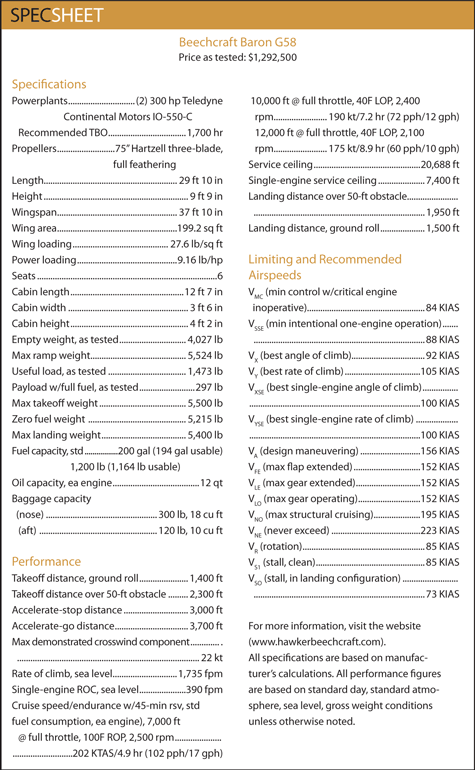
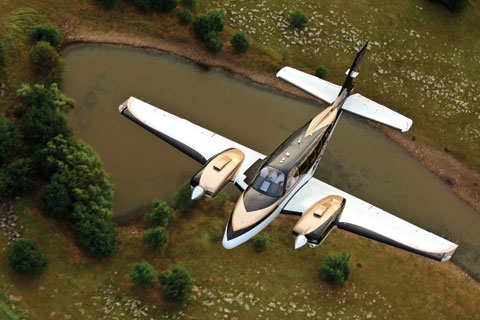
Sometimes a design simply works. And when it does, there’s no sense spending massive amounts of time and money trying to replace it. This truth is evident in many legacy airplane designs such as the Douglas DC–3, de Havilland Beaver and Otter series, Cessna’s 172, and others. Many designs have challenged and failed to unseat these airplanes as the best at what they do. And while none of these airplanes is the best in all performance categories, each is the most efficient in performing a wide variety of tasks with minimal expense to owners. That’s why you still find DC–3s working hard at 75 years of age, 50-year-old Otters carrying passengers throughout the Northwest and Alaska, and 172s still training students to fly.
For 50 years, the Beechcraft Baron has been at the pinnacle of personal air transportation. Among many worthy challengers over the decades, the Baron soldiers on as proof that legacy airplanes are still in the game of winning orders. If you need to move four people and their gear 600 nm in three hours, there are several airplanes to meet the mission. But do they have twin-engine redundancy and its resulting reassurance, known-ice capability, weather radar, the ability to get in and out of short/unimproved airstrips, or a service network that consists of, say, basically any mechanic in the country? For these reasons, there has been a Baron in the lineup at Beechcraft for five decades. And for these reasons, customers keep buying them.
Many models of Barons have been built over the years, but today, the G58 is the flame bearer. It is the most advanced Baron to date with its integrated G1000 glass cockpit and GFC 700 autopilot. Pilots are treated to a new level of situational awareness provided by the system with its integrated weather, traffic, terrain information, and Synthetic Vision Technology (SVT). And with no engine in the nose, there’s room for Garmin’s GWX 68 weather radar system to provide accurate weather pictures when the Baron gets up close and personal with storms.
Celebration
To celebrate the 50-year milestone, Beechcraft has created a special edition of the Baron. Most notable are the new 75-inch Hartzell propellers with scimitar blades that are lighter than the old props. Although Beechcraft claims no performance improvement with the new props, testing demonstrates they are slightly quieter, both for the passengers and those on the ground, which is partially attributed to their smaller diameter and radically swept blade design. Plus they look cool.
Inside, Beechcraft added some golden touches with 50-year emblems on the power quadrant and leather-wrapped control yokes. Beechcraft shields are embossed into the headrests and on the carpet in the passenger area.
The introduction of the G58 in 2006 was a watershed moment that separated all previous Barons from the G58. It is a complete integration of all the airplane’s instruments into a clean and logical presentation. No more panels full of boxes from various manufacturers displaying information on dozens of dials and displays across your field of vision.
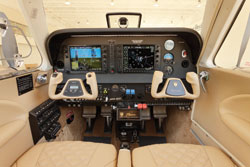 What’s most notable between old and new versions is the amount of room in the cockpit. All Barons until the 1984 model year had a panel dominated by a massive control column jutting out from the center. If a dual yoke was installed, the column took valuable cabin space from the front passenger and blocked access to radios and switches. Likewise, the engine controls were large levers—Beech 18 style (with throttles in the middle)—mounted high on the panel. The new panel ousted all the space-hogging controls, replacing the massive center yoke with conventional dual yokes. It would be nice, however, if there were a single-yoke option or a removable yoke to open up room for the right-seater.
What’s most notable between old and new versions is the amount of room in the cockpit. All Barons until the 1984 model year had a panel dominated by a massive control column jutting out from the center. If a dual yoke was installed, the column took valuable cabin space from the front passenger and blocked access to radios and switches. Likewise, the engine controls were large levers—Beech 18 style (with throttles in the middle)—mounted high on the panel. The new panel ousted all the space-hogging controls, replacing the massive center yoke with conventional dual yokes. It would be nice, however, if there were a single-yoke option or a removable yoke to open up room for the right-seater.
Barons have always been spirited performers—that has not changed. The design’s 9.16 lbs/hp power-to-weight ratio (at max takeoff weight) speaks volumes about the performance on tap behind those throttle levers. The only other twin in production today that comes close is Piper’s Seneca V with a ratio of 10.79 pounds/horsepower. These numbers are an attempt to describe the noticeable push in the back and spirited climb performance of the Baron and why so many pilots and owners have long admired it as a kick in the pants to fly.
Control harmony is a trait of the Baron that sets it apart from the competition. Pitch and roll changes in cruise require fingertip inputs and encourage clicking off the autopilot to hand-fly. Changes in power and airspeed require adjustments to pitch trim only, unlike some airplanes that require trim in all three axes. The ailerons are coordinated, so there is no adverse yaw when making turns of less than 25 degrees of bank. Purists may balk, but in the Baron you can make most turns with your feet on the floor.
Thankfully, throughout its 50 years, Beechcraft has preserved these handling qualities—and in the new airplanes, they are supplemented by an amazing suite of avionics and superb autopilot. The SVT displays terrain, traffic, and your runway right on your primary flight display (PFD). On our test flight from Milwaukee to Kansas City, the traffic advisory system alerted us to a potential disaster. With SVT, traffic is depicted on the PFD just as it would appear out the windshield in relation to the horizon. This made it easy for us to spot a flight of three light airplanes right in front of us and maneuver around them. ATC didn’t see them on radar until after we passed. Another sobering reminder that even in radar contact on an IFR flight plan, traffic avoidance is not necessarily assured.
A line of weather along the route gave us a good look at the G58’s onboard XM and Garmin weather radar systems. Having both provides a major boost in confidence that sets the Baron apart from its single-engine competitors that lack onboard radar. XM only works in the U.S. and Canada, so for flights abroad, the radar’s all you’ve got. The Baron’s MFD is videocapable, which will allow a display from an infrared camera system.
When not dodging traffic and weather, we explored the Baron’s performance at both 8,000 and 10,000 feet. These airplanes like to cruise high where true airspeeds go up and fuel burn goes down. At 8,000 feet on this warm day, density altitude was 9,800 feet, but the Baron topped out at 200 KTAS at full throttle and 2,400 rpm, burning 34 gph. The hottest cylinder at this power setting was 390 degrees Fahrenheit. Running lean of peak, the speed dropped to 190 KTAS on 27 gph and CHT of 360 degrees F.
With the props back to 2,100 rpm and mixture 40 degrees F lean of peak, the Garmin’s projected-range circle stretched from our position in northern Illinois to Key West, Florida. Fuel flow was back to 22 gph at a true airspeed of 175 knots. Standard fuel tanks hold 194 gallons, which means you can get about nine hours of endurance at long-range cruise or more than 1,500 miles of range. Yes, the Baron is equipped with a relief tube. At 10,000 feet, at a density altitude of 12,000, the Baron was still plugging along at 193 KTAS and 32 gph. Lean of peak mixture brought 185 KTAS on 24 gph.
Unfortunately, like most of us nearing middle age, the Baron has gained some weight. Empty weight is now more than 4,000 pounds. If you want to fly with full tanks, you’d better be alone with a few bags. To fill six seats with 170-pound adults, you can carry about 80 gallons of fuel, or enough to take those people on a 350-mile trip with reserves. With a load of four and bags, fuel would be limited to about 120 gallons or three hours of flight time with reserves. Partial fueling is easy and accurate with sight gauges and separate filling ports.
Model history and highlights
The Baron’s 50-year continuous production run is the longest of any twin I can think of. The only other general aviation airplane that’s been in continuous production longer would be the Bonanza. Ten models of Barons were built from model year 1961 to today. The easiest way to distinguish the various models is to look at the side windows. All 58s have four side windows. The 55s have three side windows, and those models break down into two main categories, easily determined by whether the engine nacelles have air scoops on the top. The 95-55, A55, and B55 lack the scoops. The C55, D55, and E55, which are basically small-cabin 58s, are powered by 285-horsepower Continental IO-520s and sport the air scoops as well as a longer nose and wider tailspan.
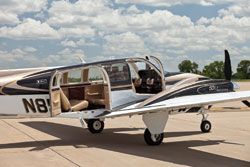 The Model 58, which debuted in the 1970 model year, stretched the C/D/E55’s fuselage 10 inches. Then the entire fuselage was relocated farther forward on the wing to improve the 55’s tendency to fall out of the aft CG limit when loaded up with six people and little or no bags in the nose for balance. Other big improvements were the addition of reversible seats in the center row allowing for club seating in the rear. Access to the rear area is via two big doors. The cabin and door changes made the 58 a true six-seater compared to the 55—its aftmost seats are accessed through a small baggage door or a crawl over the middle seats.
The Model 58, which debuted in the 1970 model year, stretched the C/D/E55’s fuselage 10 inches. Then the entire fuselage was relocated farther forward on the wing to improve the 55’s tendency to fall out of the aft CG limit when loaded up with six people and little or no bags in the nose for balance. Other big improvements were the addition of reversible seats in the center row allowing for club seating in the rear. Access to the rear area is via two big doors. The cabin and door changes made the 58 a true six-seater compared to the 55—its aftmost seats are accessed through a small baggage door or a crawl over the middle seats.
There were unique Baron models as well. One of the rarest hot rods ever built was the 56TC Turbo Baron. This model, with its 380-horsepower Lycoming TIO-541s (later used in the Beechcraft Duke), could top 250 knots at altitudes as high as 30,000 feet. More popular turbocharged Baron models were the 58TC and pressurized 58P.
The Baron's stout construction pays dividends in the form of high limiting airspeeds for maneuvering (156 KIAS) and max structural cruise speeds. Other similar airplanes require pilots to drastically slow down in the event of turbulence encounters. So the Baron can get through areas of turbulence and weather some 30 knots faster than its competitors whose maneuvering speeds are in the 120- to 130-knot range. Gear and flap speeds are also high, allowing the Baron to operate efficiently at large airports where 170 KIAS on final is the norm.
The nose baggage compartment holds 300 pounds of cargo. A small area aft of the rear seats holds an additional 120 pounds of gear. There’s also storage between the front and middle seats in the club configuration.
One thing not readily noticed by ramp lurkers is the Baron’s completely clean underwing. Like that of a Gulfstream jet, the Baron’s wing is void of draggy and unsightly flap hinges hanging under the wing. What’s most impressive about this feature is that the Baron uses Fowler flaps that extend aft a bit before going down. Mechanisms required for Fowler flaps are often hard to conceal completely inside the wing, but Beechcraft did this all the way back in 1947 with the Bonanza. Especially in older Barons that have the extended-chord flaps, this design adds a tremendous amount of lift compared to, say, the split flap arrangement of Cessna’s 310, which adds mostly drag.
What next?
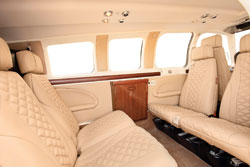 The Baron is proof that legacy airframes are still competitive in a marketplace filled with modern alternatives. Demand for twins has waned in this era of $5 per gallon fuel, but whether it will dampen demand for the Baron has yet to be seen. Will there be new Barons available 50 years from now? Doubtful. More likely a single-engine turboprop will someday replace it. Years ago, Beechcraft removed the piston engines and nacelles from a 58P and put a turbine in the nose and called it the Model 38P Lightning. Development stalled when the price went over the $1 million mark.
The Baron is proof that legacy airframes are still competitive in a marketplace filled with modern alternatives. Demand for twins has waned in this era of $5 per gallon fuel, but whether it will dampen demand for the Baron has yet to be seen. Will there be new Barons available 50 years from now? Doubtful. More likely a single-engine turboprop will someday replace it. Years ago, Beechcraft removed the piston engines and nacelles from a 58P and put a turbine in the nose and called it the Model 38P Lightning. Development stalled when the price went over the $1 million mark.
Perhaps a new lightweight turbine, such as the one being developed by Rolls- Royce, will kick-start a similar program. Beechcraft has experience with composites thanks to the Starship and Premier programs, which could result in a clean-sheet-design turbine single. Whatever may someday replace the Baron, there are thousands of pilots and owners throughout the world who will miss what has become a class-leading icon.
Pete Bedell is a pilot for a major airline and co-owner of a Beechcraft Baron D55 and Cessna 172M.


